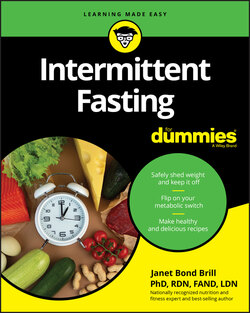Читать книгу Intermittent Fasting For Dummies - Janet Bond Brill - Страница 74
Seeing why where you store your fat matters
ОглавлениеThere is a problem with relying on traditional BMI measurements to determine whether someone is overweight or obese. These measurements ignore many people who have excessive body fat that puts them at risk of various health conditions. There is a new term being used in the medical world, namely, overfat. Overfat describes an overload of fat that builds up in certain parts of the body (the midsection), and it can affect even individuals who are of normal weight or BMI. Such a buildup of fat can pose serious metabolic threats to one’s health such as insulin resistance, high blood pressure, heart disease, stroke, and even cancer. In this section, I explore the dangers of the so-called overfat pandemic that is currently sweeping the United States and the myriad health risks of excess body belly fat and what it really means to be overfat.
Concerning body fat, location counts. Your body shape can say a lot about your health and your hormones. In other words, fat isn’t created equal. If you know you’re overweight, focus on where you’re carrying that excess body fat, which will give you a better idea of what type of fat you have. The two types of fat are as follows:
Subcutaneous: The jiggly fat located just under the skin you can pinch with your fingers and the type aesthetically bothersome
Visceral: Fat lying deep within the abdomen, surrounding the organs
Women, when they’re younger, tend to store subcutaneous fat around the hips and thighs, giving them a pear-shaped physique, mostly due to the impact of estrogen on fat distribution. A pear-shaped fat distribution is healthier; however, this fat is obstinate and is typically the hardest type of fat to lose. Pear-shaped women are better protected from metabolic diseases like diabetes compared to big-bellied people. Stubborn subcutaneous fat is not as dangerous for your health as the visceral fat that lives deep down within the abdominal cavity.
When women go through menopause, the location of where the body tends to store fat shifts, so that more body fat ends up around the middle and in the waist and tummy area. The pattern of storing fat around the middle (an apple shape) is much more strongly linked to chronic health problems than storing excess fat in the hips and thighs (a pear-shaped physique). Fat that builds up around your middle and deep within your abdomen places you at higher risk of heart disease, syndrome X, and type 2 diabetes. I discuss apple and pear shapes in Chapter 2 in greater detail.
When men gain weight, they tend to store more fat deep in the midsection of the body, which is where the dangerous type of fat lives (refer to Figure 4-2). Visceral fat penetrates way down inside, enveloping the visceral organs such as the liver, heart, kidneys, pancreas, and intestines. Visceral fat is also known as a deep fat or intra-abdominal fat. Check out the nearby sidebar for more about visceral fat.
Source: Used with permission from © logo3in1
FIGURE 4-2: Visceral fat versus subcutaneous fat.
Women tend to have more subcutaneous fat relative to men who carry a higher percentage of more dangerous visceral fat. That is until menopause, when a woman’s visceral fat storage increases as do their health risks. How do you know if you have a dangerous level of visceral fat? Your best clue is your waist size. Instead of trying to figure out how much of your visible belly fat is visceral and how much is subcutaneous, just realize that any large waistline poses a risk and is unhealthy. Waist size rises as visceral fat deposits increase. For women, a waist circumference over 35 inches is a red flag, while men should be concerned as waist size rises above 40 inches.
